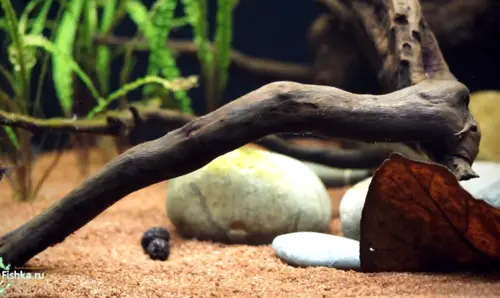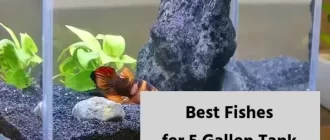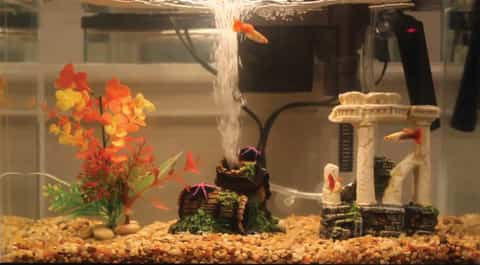The choice of driftwood for the aquarium – an important point both for the design of the aquarium, and for the health and safety of its inhabitants.
In recent years, there is a clear trend toward natural design aquariums. Most aquarists refuse all kinds of artificial decorations in favor of natural elements, among which, undoubtedly, lead driftwood.
See also: Benefits of Live Plants in Fish Tank
First, they are available: they can be purchased in specialized stores, and even better – to look for them in the woods, in the river or on the shores of the lake. The second option is more acceptable for the majority, because in stores they mostly sell driftwoods of mangrove wood and mopani (African ironwood), the price for which is quite a lot.
Secondly, with their help, you can easily create an unusual design of the aquarium, because each driftwood – individual and unique for its curves, created shapes and compositions.
What kind of wood is suitable for an aquarium?
Most suitable for aquariums are tree roots that have been in flowing bodies of water for many years. The roots of pear or walnut trees are optimal, but also willow, willow or sedge driftwood that grow on the shore will do. But branches or roots of conifers are absolutely not suitable for our purposes because of resins they contain. Keep in mind that any material you choose must be already “undead”: containing “live” sap wood needs more serious and time-consuming processing and preparation.
To make a driftwood lie on the bottom and not float, all the air, coloring and harmful substances have to get out of it. Therefore, the driftwood must be very carefully prepared before they are immersed in the aquarium.
Read also: Aquarium’s Size vs. Aquarium’s Weight
Boiling and soaking the wood

So, first clean the driftwood well by hand from the bark and existing growths, which otherwise will begin to rot once in the water. Now the future piece of decor should be boiled in salt water (140 oz of solt for 1 gal of water) for 6-12 hours, and then it should be moved to a container with clean water (can be in the bath) for another day. Ideally, place the driftwood under running water, if this is not possible, change the water every 2 hours. For boiling, use either an enamel or stainless steel bowl. Keep in mind that from galvanized or aluminum cookware harmful impurities can be absorbed into the driftwood and then enter the aquarium.
If the driftwood now sinks to the bottom, it is ready to be installed in the aquarium. However, we recommend boiling it for another 3-4 hours in a container with clean water to be sure. As a finishing touch, you can ignite it for 2 hours in an oven at 390°F. If you overcalcify a snag, it will become brittle and begin to fall apart.
Good to know: Choosing Right Air Pump for Your Fish Tank
Other ways to prepare driftwood

Driftwood that have been found in salt water can also be used in freshwater aquariums, but if they are from the ocean, they need to be soaked well in whitewater beforehand. In this way, you will insure yourself against the possibility of any harmful substances and organisms getting into your artificial reservoir.
If the driftwood is too big and you do not have a container to boil them, soak the wood in a saturated solution of manganese dioxide (up to 1 tbsp. per bucket of water). Keep in mind, however, that you will not be able to sterilize the deep layers of wood in this way.
Water staining in an aquarium with driftwood – a natural process
Keep in mind that during the first time tannins from driftwood will get into the water, and because of this the water will begin to color in tones from light amber to brown. This is a temporary phenomenon, and soon this process will stop, although the water in the aquarium with snags will always have a yellowish-brown color. To remove substances trapped in the water from the wood, place activated charcoal, bought at a pet store, in the filter.
Another point: the water in the pond, where the snag is located, will be softer, and, therefore, you can safely inhabit it discus, scalarians.
How to fix the driftwood floating in aquarium
If the driftwood now sinks to the bottom, it is ready to be installed in the aquarium. However, we recommend boiling it for another 3-4 hours in a container with clean water to be sure. As a finishing touch, you can ignite it for 2 hours in an oven at 200 ° C. If you overcalcify a snag, it will become brittle and begin to fall apart.
By the way, snags – a useful “product” for catfish plekostomusov, which nibble wood fibers, and their stomachs process these fibers into cellulose, which has a positive effect on the digestion of fish.
Other ways to prepare driftwood

Snags that have been found in salt water can also be used in freshwater aquariums, but if they are from the ocean, they need to be soaked well in whitewater beforehand. In this way, you will insure yourself against the possibility of any harmful substances and organisms getting into your artificial reservoir.
If the snags are too big and you do not have a container to boil them, soak the wood in a saturated solution of manganese dioxide (up to 1 tbsp. per bucket of water). Keep in mind, however, that you will not be able to sterilize the deep layers of wood in this way.
Water staining in an aquarium with driftwood – a natural process
Keep in mind that during the first time tannins from driftwood will get into the water, and because of this the water will begin to color in tones from light amber to brown. This is a temporary phenomenon, and soon this process will stop, although the water in the aquarium with snags will always have a yellowish-brown color. To remove substances trapped in the water from the wood, place activated charcoal, bought at a pet store, in the filter.
Another point: the water in the pond, where the snag is located, will be softer, and, therefore, you can safely inhabit it discus, scalarians.
How to fix the floating snags at the bottom of the aquarium

If your aquarium will not have fish, you can not especially “bother” with the treatment of wood. For the purely decorative effect is suitable for any snags. If it turns out that it does not sink, make it heavier: drill and pour tin inside. Another way to secure the snags is to use suction cups, which can be attached to it with glue or screws. However, keep in mind that plastic suction cups over time become coarse and stop holding on the glass.
Now cover the well-dried wood with epoxy varnish in 2-3 layers, let it dry well, and then soak the future decorative element in a container with running or changing water. That’s it! You are ready “eternal”, not rotting snags! In this case, it does not even matter the species of wood.
If your aquarium will not have fish, you can not especially “bother” with the treatment of wood. For the purely decorative effect is suitable for any snags. If it turns out that it does not sink, make it heavier: drill and pour tin inside. Another way to secure the snags is to use suction cups, which can be attached to it with glue or screws. However, keep in mind that plastic suction cups over time become coarse and stop holding on the glass.
Now cover the well-dried wood with epoxy varnish in 2-3 layers, let it dry well, and then soak the future decorative element in a container with running or changing water. That’s it! You are ready “eternal”, not rotting snags! In this case, it does not even matter the species of wood.
A white stain on the driftwood
Sometimes you can observe the appearance of white scum on driftwood, especially if they have not been well treated. Observe the fish to determine if the plaque is bad for them. If you have catfish in your aquarium, they can handle it just fine. And not only with plaque, but also with saprophytic fungi, which in most cases are present on the snags. However, you can only see them if you have submerged live wood in the pond, or the snags stick out of the water, or there is no one to scrape them off.





